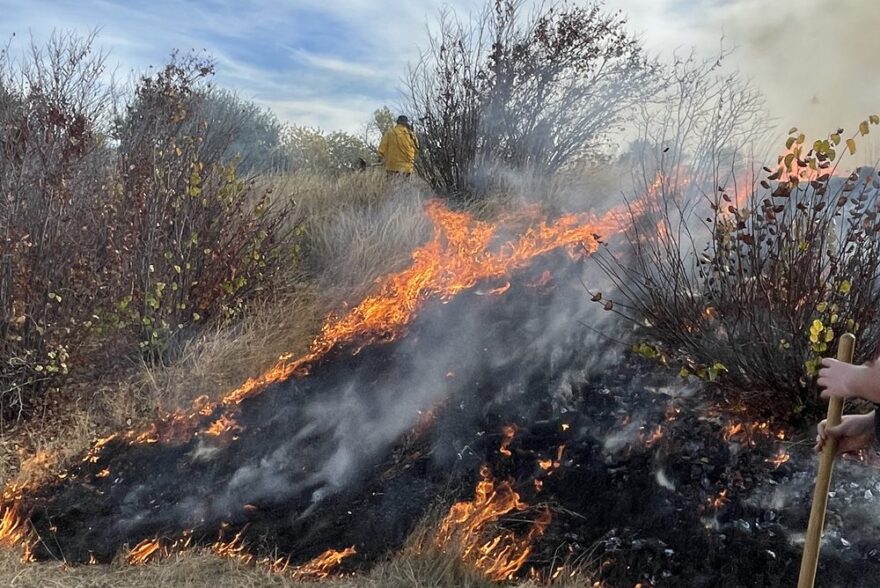Nov. 2023 Science Corner | Cultural Burning: Traditional Ecological Knowledge in Practice


Prescribed burns are gaining popularity as a proactive measure to mitigate catastrophic wildfires, but as Indigenous people know all too well, the use of fire for landscape stewardship has not always been embraced.
Written by: Saraya Hamidi, Indigenous Partnerships Manager
As Indigenous people have known for generations, fire is an integral aspect of forest health and a necessary component of stewarding resilient forests. Prescribed burns are gaining popularity as a proactive measure to mitigate catastrophic wildfires, but as Indigenous people know all too well, the use of fire for landscape stewardship has not always been embraced.
In 1850, before California was officially granted statehood, the California Legislature passed the Act for the Government and Protection of Indians. This piece of legislation removed Indigenous people from homelands, “legalized” their enslavement, and outlawed the use of fire for stewardship. Indigenous people who had stewarded with fire for generations now risked arrest, or even death, as one district ranger suggested, for putting fire on the ground.
It wasn’t until 1937 that the Act was repealed, and then 2022 that California passed legislation affirming the use of cultural fire to steward lands after decades of fire suppression proved detrimental to the landscape.
But what is cultural fire, and is it different from the prescribed fire that non-Indigenous agencies use to steward lands? While the two practices are often conflated, they are fundamentally different in purpose and in practice.
This month, Cache Creek Conservancy and the Yocha Dehe Wintun Nation hosted a Leok Po (Good Fire in Wintun) Demonstration led by cultural practitioners and Traditional Ecological Knowledge holders, including Diana Almendariz, a cultural practitioner of Maidu/Wintun and Hupa/Yurok descent and friend of Blue Forest. I, along with other Blue Forest staff, had the opportunity to attend a cultural burn demonstration at the Cache Creek Conservancy Tending and Gathering Garden. During this workshop, Indigenous stewards shared the core pillars of cultural fire.
Purpose: While prescribed burns are primarily conducted to reduce fuel loads, thereby reducing the risk of catastrophic wildfires, cultural burns are used to restore balance to the ecosystem as a whole. Cultural fires are used to promote soil nutrition, promote growth of first foods and medicinal plants, prompt seed regeneration, and prepare plants to become good basketry materials.
Preparing to burn: Cultural burns are by no means a one-size-fits-all approach to stewardship. They can only be conducted by the local Indigenous Peoples, who determine the burn plan with their use of the landscape in mind. When ready to burn, practitioners may start a fire, using bundles of tule and cattail as torches rather than the drip torches used for prescribed burns. Cultural burns also burn lower to the ground and slower than prescribed burns.
Post-burn: Cultural burn practitioners steward the soil by raking the charred soil into the ground, and eventually returning to gather basket materials and medicinal plants and identify future areas to burn. Practitioners return to gather basket materials and medicinal plants and identify future areas to burn.
While cultural burns and prescribed burns both benefit the health of the landscape, cultural burns offer a holistic approach that supports the overall health of the ecosystem, as well as the people who steward it, presenting a compelling case for more cultural burns. Federal and state agencies are following suit, as demonstrated by CalFire’s participation in and support of the workshop.
I ended my day at the workshop with a question: Why can’t all burns be cultural burns? Why not approach all intentional fire in this holistic way? Clint McKay (Wappo, Pomo, and Wintun), a cultural expert and Indigenous Education Coordinator at Pepperwood Preserve, shared that all burns could be cultural burns. But, change is slow and requires the guidance of the local Indigenous Peoples.
I hope to see this shift toward Indigenous stewardship increase to a point where all prescribed burns become cultural burns, where all treatments on the landscape are approached with respect for Indigenous values. As a team member of an organization that supports restoration projects using beneficial fire, I am excited by the shift toward cultural fire and how it will holistically heal our landscapes and, with that, restore our relationship with the land.
To learn more, watch this video of the workshop.